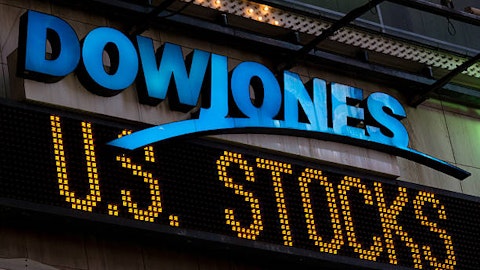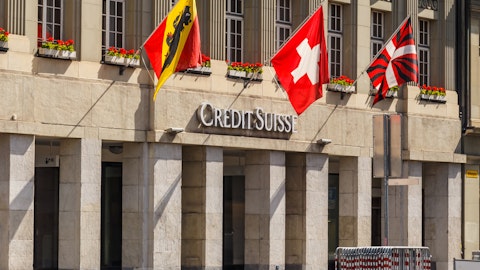The Goldman Sachs Group, Inc. (NYSE:GS) Q1 2023 Earnings Call Transcript April 18, 2023
The Goldman Sachs Group, Inc. beats earnings expectations. Reported EPS is $8.79, expectations were $8.1.
Operator Good morning. My name is Katie, and I will be your conference facilitator today. I would like to welcome everyone to the Goldman Sachs First Quarter 2023 Earnings Conference Call. This call is being recorded today, April 18, 2023.Thank you. Ms. Halio, you may begin your conference.Carey Halio Good morning. This is Carey Halio, Head of Investor Relations and Chief Strategy Officer, Goldman Sachs. Welcome to our first quarter earnings conference call. Today we will reference our earnings presentation, which can be found on the Investor Relations page of our website at www.gs.com. Note information on forward-looking statements and non-GAAP measures appear on the earnings release and presentation. This audiocast is copyrighted material of The Goldman Sachs Group Inc.
and may not be duplicated, reproduced, or rebroadcast without our consent.I am joined today by our Chairman and Chief Executive Officer, David Solomon, and our Chief Financial Officer, Denis Coleman. Let me pass the call to David.David Solomon Thanks, Carey, and good morning, everyone. Thank you for joining us.In the first quarter, we delivered solid performance in a challenging environment. We produced net revenues of $12.2 billion and generated earnings per share of $8.79 and an ROE of 11.6% and an ROTE of 12.6%. The first quarter was certainly volatile, particularly for the banking sector. After a fairly benign operating environment at the start of the year, in March, we witnessed the collapse of two regional banks in the United States.Stress quickly spread to a number of institutions across the financial sector where we saw ratings downgrades and steep valuation declines in very short order.
These stresses were not limited to the U.S., as we saw when regulators help arrange the combination of Switzerland’s two largest financial institutions.It’s important to appreciate the size of the disruption. Some of the market moves during the period were staggering, particularly in interest rates. To give you a sense of the magnitude, there have been just four days in the past 25 years that have seen two-year yields move by 50 basis points or more intraday. One was in September 2008 and three of them occurred in mid-March this year. Monday, March 13th was the biggest one-day move in the U.S. Treasury two-year yield in over 35 years.As we sit here today, it appears that the worst of the volatility is behind us. Prompt action by regulators was vital in bolstering confidence and stabilizing market sentiment.
The events of the first quarter acted as another real-life stress test and they demonstrated the resilience of the country’s largest financial institutions.The G-SIBs have been a source of strength for the financial system. We joined a consortium with 10 other large institutions in making a $30 billion uninsured term deposit into First Republic Bank to send the strong vote of confidence in and commitment to the U.S. banking sector.As for Goldman Sachs, our long-standing and deeply rooted risk management culture helped us navigate this unusual environment. In our 154-year history, we have lived and managed through many periods of disruption, and it’s our rigorous processes and planning for tailored scenarios before the stress that enable us to react quickly and effectively when they do occur.While it’s impossible to predict the exact form a market stress will take and we won’t always execute perfectly, our risk management culture, strong liquidity, and robust capital position have allowed us to navigate a complex environment while also continuing to actively support our clients.Given this backdrop, it was clear our clients needed help managing their risks and turn to us for our expertise and execution capabilities.
Both FICC and Equities had a strong quarter, as we helped clients with their intermediation and financing needs.Underwriting activity, however, remained extremely muted and below recent averages as capital markets were further delayed from reopening in a meaningful way given the market disruption. All-in, Global Banking & Markets delivered industry-leading returns of 16.6%, in line with our through-the-cycle targets even while advisory and capital markets activity remained muted. This franchise continues to show impressive resilience in a variety of market environments, given our broad and diversified set of businesses.Management fees across Asset & Wealth Management grew sequentially, but segment returns were in the mid-single-digits as our on-balance sheet investments remained susceptible to volatility in asset prices.
It is a strategic priority to continue to reduce these positions. And while we’ve made progress, there is still work to do.In Platform Solutions, we saw positive underlying trends this quarter with revenues greater than provisions and we remain focused on driving this business towards profitability. We also continue to explore strategic alternatives within our consumer platform businesses.In the first quarter, we sold a portion of our Marcus loan portfolio and transferred the remainder to held-for-sale. While this activity is now reflected in our AWM segment, it is an example of our narrowing our focus in the consumer space. Denis will take you through the financial impact of that momentarily.Additionally, we are now initiating the process to explore the sale of GreenSky.
We believe GreenSky is a good business and is performing well with first quarter originations in our core home improvement loans up over 25% year-over-year and a weighted FICO on total originations of over 780. Given our current strategic priorities however, we may not be the best long-term holder of this business. We will update you on our progress if and when there are material developments.As I close, I’d like to say a few words about the forward outlook. The recent events in the banking sector are lowering growth expectations and there is a higher risk of a credit contraction given the environment is limiting banks’ appetites to extend credit. This is an acceleration of a trend and a situation we’re watching closely. Businesses and consumers continue to adjust to higher interest rates.
While the forward trajectory is still unclear, we continue to be cautious about the economic outlook and we are operating the firm such that we are well prepared in the event that the environment weakens further.Overall, I feel very confident about the state of our client franchise and the long-term opportunity set for Goldman Sachs. As the events of the past quarter have illustrated, we are operating from a position of strength and we have the people in place around the world to continue serving the broad range of clients’ needs with excellence.And while much has transpired since we held our Investor Day at the end of February, we remain focused on our strategy to strengthen our leading Global Banking & Markets franchise and grow our Asset & Wealth Management business, and we are committed to delivering for clients and shareholders.I will now turn it over to Denis to cover our financial results for the quarter in more detail.Denis Coleman Thank you, David.
Good morning.Let’s start with our results on page one of the presentation. In the first quarter, we generated net revenues of $12.2 billion and net earnings of $3.2 billion, resulting in earnings per share of $8.79.Turning to performance by segment, starting on Page 3. Global Banking & Markets produced revenues of $8.4 billion in the first quarter, which generated an industry-leading ROE for the segment of 16.6%. Advisory revenues of $818 million were down 27% amid lower industry completions. Underwriting revenues continued to be below recent averages and were lower year-over-year.Despite the difficult backdrop, we were number one in the league tables for completed M&A and high-yield debt underwriting. We also ranked second for equity and equity-related underwriting.
Our backlog fell quarter-on-quarter, primarily in Advisory, but we remain cautiously optimistic on the outlook for the second half of the year and 2024, particularly for strategic M&A. We also expect investors will need more certainty before financing markets reopen broadly, but we have seen an increase in underwriting dialogs in the first two weeks of the second quarter.FICC net revenues were $3.9 billion in the quarter, down 17%, as one of our strongest sets of results in rates was more than offset by significantly lower currencies and commodities revenues, which were very strong in the first quarter of 2022. In FICC financing, revenues rose slightly year-over-year.Equities net revenues were $3 billion in the quarter, down 7% year-on-year.
A decline in intermediation revenues was partially offset by record financing revenues of $1.3 billion with the sequential increase driven by higher activity and increased balances coupled with improved customer spreads.Moving to Asset & Wealth Management on Page 5. Revenues of $3.2 billion rose 24% year-over-year, given improved results in equity and debt investments, and as management and other fees increased 12% year-over-year to a record $2.3 billion. Though underlying trends in the business remained strong, private banking and lending revenues of $354 million fell year-over-year, driven by the partial sale of our Marcus unsecured loan portfolio as well as a transfer of the remaining portfolio to held-for-sale, in line with our strategic decision to narrow our consumer ambitions.The associated revenue reduction of $470 million was largely offset by a reserve release of $440 million.
Additionally, we benefited from NII and incremental reserve releases associated with paydowns. All-in, the Marcus loan portfolio was profitable for the quarter.Net revenues for equity investments were $119 million, driven by $229 million in revenues related to CIEs and $85 million of gains related to our $2 billion public portfolio, partially offset by $195 million of net losses on our $12 billion private equity portfolio, primarily within real estate.This quarter, we experienced approximately $355 million of impairments on our CIE portfolio, which are reflected in operating expenses. Debt investments revenues were $408 million, driven by net interest income of $363 million.Moving on to Page 6, total firmwide assets under supervision ended the quarter at a record $2.7 trillion, driven by $68 billion of market appreciation as well as $8 billion of long-term net inflows, representing our 21st consecutive quarter of long-term fee-based inflows.
We also saw a meaningful strength in liquidity products with $49 billion of net inflows from new and existing clients amid the industry-wide flows in the money market funds.Turning to Page 7 on alternatives. Alternative assets under supervision totaled $268 billion at the end of the first quarter, driving $494 million in management and other fees for the quarter. Gross third-party fundraising was $14 billion, relatively solid given the current environment, and bringing total third-party fundraising since our 2020 Investor Day to $193 billion. While we expect the pace of fundraising to slow for the rest of 2023, we continue to feel good about the path forward and remain confident in achieving our 2024 target of $225 billion.On balance sheet alternative investments totaled approximately $57 billion, of which $27 billion was related to our historical principal investment portfolio.

TaLaNoVa/Shutterstock.com
Despite the challenging environment, we reduced these on balance sheet historical investments by $2.3 billion in the quarter. We are committed to our strategy to reduce balance sheet density, including reducing historical principal investment portfolio to less than $15 billion by 2024 year-end.I’ll now turn to Platform Solutions on Page 8. Revenues of $564 million more than doubled year-over-year, driven by growth in loan balances in consumer platforms. This week, we announced the launch of a savings account for Apple Card users. We are excited to deepen our partnership with Apple through this additional offering and to introduce another source of deposit funding for the firm.In transaction banking, deposit balances ended the quarter slightly higher versus year-end, while revenues of $74 million were modestly lower quarter-over-quarter amid higher deposit costs.
As we spoke about at our Investor Day in February, we’re focused on further scaling this business with new clients and deepening our relationships with existing clients as we aspire to become their primary service provider. In this regard, we continue to see positive momentum on the platform as our client count grew by approximately 20% in the first quarter.On Page 9, firmwide net interest income of $1.8 billion in the first quarter was down 14% relative to the fourth quarter, driven by increased funding costs supporting training activities within Global Banking & Markets. Our total loan portfolio at quarter end was $178 billion, essentially unchanged versus the fourth quarter. Provision for credit losses reflected a net benefit of $171 million, including the previously mentioned reserve release associated with the Marcus unsecured lending portfolio and model updates, which were only partially offset by roughly $245 million in consumer net charge-offs.Spending a moment on our commercial real estate lending portfolio, as of quarter-end, we had $29 billion of funded CRE loans.
This portfolio is diversified by property type and includes $10 billion of exposure in the form of conservatively structured warehouse lending with typical LTVs of approximately 50%.Turning to expenses on Page 10. Total quarterly operating expenses were $8.4 billion. Our compensation ratio for the quarter net of provisions was 33%. Quarterly non-compensation expenses were $4.3 billion, essentially unchanged versus the fourth quarter, but up versus last year. The majority of the year-over-year increase was driven by the aforementioned CIE impairments as well as expenses related to NNIP. Our effective tax rate for the quarter was 19%. For the full year, we expect a tax rate between 21% and 22%.Turning to capital on Slide 11. Our common equity Tier 1 ratio was 14.8% at the end of the first quarter under the standardized approach, 100 basis points above our current requirement and at the top end of our management buffer.
In the quarter, we returned $3.4 billion to shareholders, including common stock repurchases of over $2.5 billion and common stock dividends of roughly $870 million.While we expect to continue to focus on sustainably growing our dividend, we would note that repurchases in any given quarter will vary. Though we find our stock price attractive at current levels in light of the current environment, we expect to moderate our repurchase levels in the second quarter relative to the first quarter.In conclusion, our first quarter results were solid in the context of a volatile environment. Our robust financial position allowed us to focus on serving our clients and helping them navigate this period of market disruption. Across our leading businesses in Global Banking & Markets and Asset & Wealth Management, we remain well positioned to continue to support our clients and execute on our strategic priorities.With that, we’ll now open up the line for questions.
See also 11 Best Waste Management Stocks to Buy Now and 35 Most Beautiful Places In The World.
Question-and-Answer Session
Operator: Thank you.
[Operator Instructions] We’ll take our first question from Glenn Schorr with Evercore.Glenn Schorr Hi, there. Curious, you mentioned being optimistic about M&A in the back-half, particularly on the strategic side. I’m curious what and how you — what you’re seeing that gives you that confidence. Obviously it must be conversations. And then what about the sponsor community? Thanks.David Solomon Yes. Thanks, Glenn. And so appreciate the question, and you’re right. It has to do with dialogs and things that we can see. I’d say as we came into the new year, there’s no questions dialogs have picked up. There’s no question — and I always talk about this when we talk about it broadly, confidence affects the ability for people to move forward to be active in the M&A market and certainly what’s gone on over the course of the last four weeks has slowed down some of the dialogs.But when you think about big strategic activity, I think most big companies continue to operate from a position where they’re trying to make sure they have the scale and the strength competitively to advance their strategies.
And so those strategic dialogs are quite active. And if you actually look over the course of the last week or two, there have been a handful of deals that have been announced that highlight that. We’re seeing more dialogs like that and so we’re hopeful that more of that will come to fruition. I just think that’s a steady part of the diet. The companies need to continue to execute on to improve their strategic position.Now, with respect to financial sponsors, we’re still going through a reset. I’m encouraged by the fact in the quarter, we saw one or two deals where kind of the bid offer between the value that a financial sponsor could achieve and the financing price came to a — came to meet. There was a good data point and a sell-down of a legacy deal in the market, but I would say the financial sponsor activity is still muted and there is more upside as the reset on both value and financing cost continues.I think we’re going to get there.
I’d expect more in the second half of the year unless there was a really strong, a much more pronounced economic disruption because it just takes time for people to reset. We’ve now kind of gone through five quarters of reset. And so generally speaking, historically, you kind of see these things turn on after four to six quarters. So I would just expect more of a base level of activity from what’s been very, very muted.Glenn Schorr Appreciate that. And building on that, your comment about companies wanting to build on their strategic position, maybe we could talk a little bit about your transaction banking platform because it’s still growing. I’m just curious on the March events that we saw, did it cause any rethinking or maybe encouragement in terms of the direction of what you’re doing with transaction banking and taking on those deposits?
And did you notice any — was there any noticeable behavior of how those deposits acted during the March crisis? Thanks.Denis Coleman Glenn, it’s Denis. Thanks for the question. I’d say that our conviction around the transaction banking business remains very, very strong. I think what we were able to observe in the first quarter, I highlighted in my script and it’s something that we’re focused on strategically, is, we grew the client count by about 20% in the quarter, which is a similar amount to all of last year. And we’re very, very focused on continuing to improve our position with our clients, offer them more and more services and grow this business steadily over the long-term to create value.I think in terms of how the deposits themselves performed over the course of the quarter, they were in line with our expectations, and as we indicated, they ended on a quarter-over-quarter basis up just about $1 billion.Operator Thank you.




